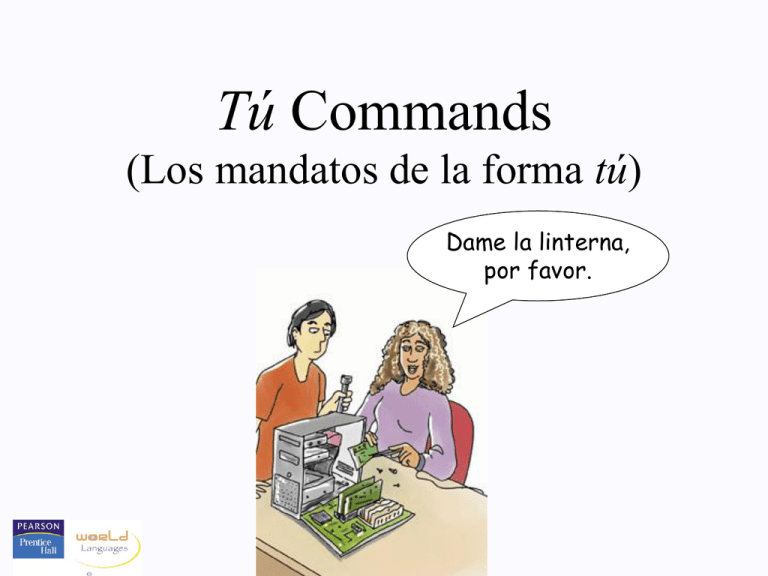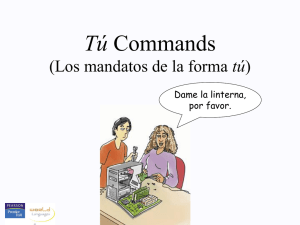Tú tú Dame la linterna, por favor.
advertisement

Tú Commands (Los mandatos de la forma tú) Dame la linterna, por favor. Tú Commands For regular affirmative commands . . . Think like él. The regular affirmative tú command has the same form as the él form of the verb in the present indicative. Tú Commands For regular affirmative commands . . . Él habla. ¡Habla tú! He speaks. Speak! Él come. ¡Come tú! He eats. Eat! Él escribe. ¡Escribe tú! He writes. Write! Tú Commands For regular negative commands . . . Revert to the subjunctive. The negative tú command has the same form as the tú form of the verb in the present subjunctive. Tú Commands For regular negative commands . . . Affirmative ¡Habla! Negative ¡No hables! Speak! Don’t speak! ¡Come! ¡No comas! Eat! ¡Escribe! Write! Don’t eat! ¡No escribas! Don’t write! Tú Commands In Capítulo 11 you learned that formal commands used the forms of the subjunctive. The informal (tú) commands, by contrast, use the subjunctive only in their negative forms. Notice the following chart. Infinitive comprar comer escribir pensar dormir pedir traer Affirmative compra come escribe piensa duerme pide trae Negative (Subjunctive) no compres no comas no escribas no pienses no duermas no pidas no traigas (compres) (comas) (escribas) (pienses) (duermas) (pidas) (traigas) Remember . . . Tú Commands Regular affirmative tú commands have the same form as the third-person singular of the present indicative. Recicla los platos de papel. Protege nuestros bosques. Recycle the paper plates. Protect our forests. Negative tú commands use the subjunctive. No cortes los árboles pequeños. Don’t cut down the small trees. Don’t close the factory No cierres la fábrica todavía. yet. Irregularities in the subjunctive will also appear in the negative tú commands. No conduzcas tan rápido. No te vayas. Don’t drive so fast. Don’t leave. Verbs with irregular affirmative forms When listed in the following order, the initial letters of each verb provide the acronym TVVDSHIPS, a useful memory device. Verb Affirmative command Tener Venir Valer D ecir Salir H acer Ir Poner Ser ten ven val di sal haz ve pon sé Negative command no tengas no vengas no valgas no digas no salgas no hagas no vayas no pongas no seas Verbs with irregular affirmative forms Some sample sentences using irregular forms: Ten confianza. Ven a mi oficina. Val algo. Di la verdad. Sal inmediatamente. Haz la inspección. Ve a la reunión. Pon el libro en la mesa. Sé amable con todos. No tengas miedo. No vengas tarde. No te valgas del dinero. No digas tonterías. No salgas sin mí. No me hagas enojar. No te vayas. No pongas esa cara. No seas grosero. Object pronouns with tú commands As with the formal commands, attach pronouns to the end of affirmative commands and place them in front of the negative command. Remember to place an accent on the next-to-last syllable of the verb in the affirmative command form. Recíclala mañana. Recycle it tomorrow. No le pongas la multa a la estudiante. Don’t give the fine to the student. Object pronouns with tú commands The irregular affirmative command forms (except for sé) do not take a written accent unless more than one pronoun is added to the end of the verb. ¿La mesa? Sí, ponla por favor. The table? Yes, set it, please. Dime, ¿adónde vas? Tell me, where are you going? ¿Sabes su teléfono? Dímelo, por favor. Do you know his telephone number? Tell it to me, please. FIN

